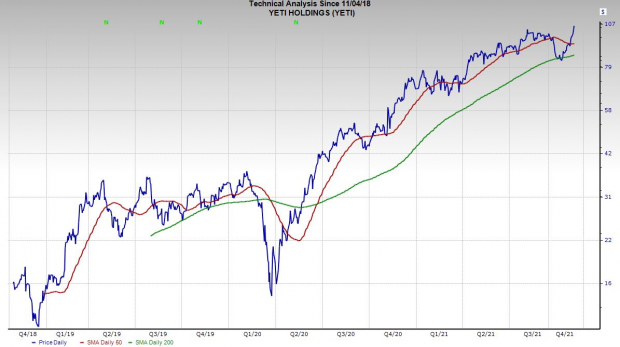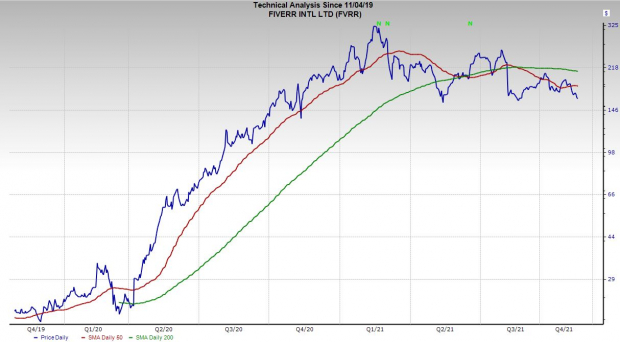The early-November market momentum continued mid-week after the Federal Reserve provided clarity on its tapering plans. Stocks then climbed again Thursday, with the Nasdaq and the S&P 500 both setting new records once again.
The S&P 500 has now jumped over 8% in the last month, while the Nasdaq has surged nearly 12% since it began to bounce out of oversold technical levels on October 4. The Dow has also popped roughly 6% during this stretch.
The recent positivity came after the Fed approved plans to begin scaling back its bond-buying this month. The central bank hopes to end its run of stimulus-focused bond purchases by June, while leaving interest rates unchanged during this stretch.
The market reacted positively to the Fed’s updates and continued to show its love for the stronger-than-projected third quarter earnings season. Wall Street pushed the market to records despite rising prices and supply chain bottlenecks because these headwinds haven’t materialized in the broader S&P 500 margins picture for this year and beyond, at least not yet.
Plus, the consumer-driven U.S. economy flashed signs of a comeback to start the fourth quarter, with some solid retail-based data in October. All that said, stocks could face some near-term selling pressure after the huge month-long run has things a bit overheated.
Still, investors with long-term horizons should always remain on the hunt for strong stocks because market timing is extremely difficult. Today, we dive into two stocks to consider buying heading into their upcoming earnings results…
Yeti Holdings, Inc.
YETI
– (
Q3 FY21 Results Due November 11
)
Yeti grew its customer base for its rugged, reliable, and simply-branded coolers that cost up to $1,300 by expanding way beyond its massive white coolers. Today, the firm sells a growing array of styles, sizes, and colors. It also sells multi-purpose buckets, gear-boxes, outdoor chairs, dog bowls, and more.
The star of its growing portfolio is drinkware. The unit includes tumblers, mugs, bottles, jugs, and other items and it accounted for nearly 60% of total FY20 revenue.
Yeti has also ventured deeper into the bag market, rolling out more luggage, backpacks, and duffels. Wall Street might start to focus more on Yeti’s opportunity to compete against the likes of Away and other popular and expensive travel bags. Its diversified portfolio helped it grow its revenue by 20% to $1.1 billion last year, with direct-to-consumer sales up 50% to account for nearly half of sales.
Along with its vital DTC business, its wholesale unit remains solid and it sells to the likes of Dick’s Sporting Goods
DKS
, Walmart
WMT
, and beyond.
Yeti has slowly built out its brick-and-mortar business outside of its flagship store in Austin, Texas. Overall, Yeti is part of a group of newer, higher-end brands thriving in the Amazon
AMZN
era that includes the likes of Lululemon
LULU
and Peloton
PTON
.

Image Source: Zacks Investment Research
Yeti management has upped its guidance in 2021 despite supply chain setbacks and it’s poised to benefit from strong consumer spending, highlighted by pent-up demand, especially amid higher-income households who can afford $40 mugs and $300-plus coolers. Zacks estimates call for Yeti’s FY21 sales to surge 28% to reach $1.40 billion, with FY22 revenue projected to climb another 16% higher.
The company’s adjusted earnings are projected to jump 33% this year and another 17% in 2022. Yeti topped our EPS estimates by an average of 44% in the last four periods. And its most recent Q3 earnings estimate comes in 5% above consensus. Yeti is also part of the Leisure & Recreation division that sits in the top 20% of over 250 Zacks industries as we enter the heart of the holiday shopping season.
Yeti currently lands a Zacks Rank #3 (Hold) and seven of the 10 brokerage recommendations Zacks has are either “Strong Buys’ or “Buys,” with nothing below a “Hold.” Yeti shares have soared since their 2018 IPO and are up 60% in 2021. This includes a nearly 30% climb since the early part of October, as investors piled back into Yeti and many other names after they reached oversold technical levels.
Yeti broke records again on Thursday of roughly $107 a share, and its consensus price target still marks upside to its closing price. On top of that, it’s trading at a 10% discount to its own year-long high in terms of forward earnings.
The stock could face a near-term pullback given its run and some investors might want to wait for the dust to settle after its report. But those with long-term horizons don’t need to focus as much on market timing.
Fiverr
FVRR
– (
Q3 FY21 Results Due November 10
)
Fiverr began creating an on-demand, e-commerce-esque experience that “makes working with freelancers as easy as buying something on Amazon” roughly 10 years ago. FVRR aims to connect small businesses and other organizations with people and freelancers for defined “Gigs,” from graphic design and programming to digital marketing and translation.
Fiverr’s platform is focused on business-to-business style digital services. The company’s digital service catalog has expanded from eight categories to over 500, across nearly 9 verticals for almost anything digitally-based.
The firm stresses that businesses aren’t hiring temp workers. Instead, they are buying defined, service-based products, with transparent pricing and due dates. Firms can easily browse and search for various options for whatever it is they need via broader or refined search parameters. The platform is equally appealing for freelancers.
Fiverr is slowly expanding its reach through some acquisitions. And the coronavirus highlighted the possibilities of the work
wherever, whenever
world and showcased the continued growth of e-commerce. More importantly, a hybrid working life could certainly be the long-term future of many.

Image Source: Zacks Investment Research
FVRR’s revenue jumped 41% in 2019 and 77% in 2020. The firm said that during the 12-month period ended in June that 4 million customers bought a wide range of services from freelancers across more than 160 countries.
The economic reopening has impacted its business. Nonetheless, Zacks estimates call for its revenue to climb 51% in 2021 and another 34% in 2022 to reach $382.5 million.
Fiverr’s adjusted earnings are projected to slip from $0.29 a share to $0.02 this year. But Wall Street might soon turn its focus to its FY22 expectations that call for a massive jump all the way to $1.15 a share.
The company has also crushed our bottom-line estimates in the trailing four periods, including a 46% Q2 beat. And four of the eight brokerage recommendations we have are either “Strong Buys” or “Buys,” with only one “Sell”-level ranking.
FVRR, which went public in the summer of 2019, was one of the coronavirus high-flyers, having skyrocketed from $25 a share in March 2020 to over $300 by February. The stock was clearly due for a huge pullback and it closed regular trading Thursday 50% below its records at $164 a share.
Fiverr is also closing in on oversold RSI levels (30 or under) at 33. And its Zacks consensus price target of $215 a share marks 30% upside to its current levels. It is also trading at new 12-month lows in terms of forward sales. All of this could provide Fiverr with plenty of growth runway.
Zacks’ Top Picks to Cash in on Artificial Intelligence
This world-changing technology is projected to generate $100s of billions by 2025. From self-driving cars to consumer data analysis, people are relying on machines more than we ever have before. Now is the time to capitalize on the 4th Industrial Revolution. Zacks’ urgent special report reveals 6 AI picks investors need to know about today.
See 6 Artificial Intelligence Stocks With Extreme Upside Potential>>
Want the latest recommendations from Zacks Investment Research? Today, you can download 7 Best Stocks for the Next 30 Days.
Click to get this free report








